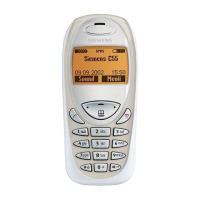V1.20 Page 30 of 48 ICM MP CCQ GRM
A55/C55_Hitachi Company Confidential © Copyright Siemens AG 04/03
Functions
Pin
Requirements
Sequence
Watchdog
monitoring
WDOG As soon as the first WDOG (PinH3) pin rising is
detected during the TE4 timer, the device start
the watchdog monitoring procedure. Standard
switch off of the phone is the watchdog. The
first edge of watchdog is rising. If a falling edge
is detected as the first transient the device will
go to power down mode again and the whole
phone is switched off. Rising and falling edges
must be detected alternated. With any edge on
WDOG (PinH3) pin a counter will be loaded.
The next - compared to the previous edge -
inverted edge must occur between end of T1,
and end of T2. If the signal occurs before end
of T1 or is not detected until end of T2, the
device will go to power down mode
immediately after the violation of the watchdog
criteria occurs.
T1 min. 0,327s/ typ. 0,360s/ max. 0,400s
T2 min. 2,600s/ typ. 2,860s/ max. 3,178s
Power-On-Reset
(POR)
RESET_N
RESET2_N
To guarantee a correct start-up of the ASIC, a
power on reset is needed at first power supply
ramping. Therefore a static/dynamic power on
reset circuit is added, which creates a reset
each time the power supply is connected. After
POR the ASIC starts up the reference and the
oscillator, read in the fuse content and goes
back to power down mode. If the power supply
will drop under the POR threshold a
synchronous reset is done and the ASIC will go
to power down mode independently of the
previous operating mode.
Voltage Supply
Logics
REG1
(2.9V)
The linear controller is designed for 2.9V(±2%)
and a maximum load current of 140 mA.
Voltage and current for the external Logic is
supplied from the internal 2.9V logic regulator.
The operating voltage VREG1 is kept constant
up to the maximum rated load current. A
reference voltage for the regulator circuit is
generated from a bandgap reference
Voltage Supply
Logics
REG2
(1,92V)
The linear controller is designed for
1.82V(±3%) and a maximum load current of
300 mA.
The REG2 supplies the Baseband Processor.
For a high power application, the power has to
be dissipated outside of the chip. This is done
with a series diode at the input of REG2, which
will force the regulator to a lower input voltage
and therefore lower power dissipation.

